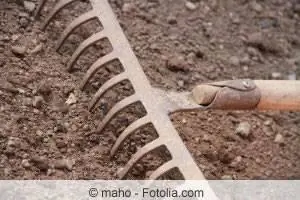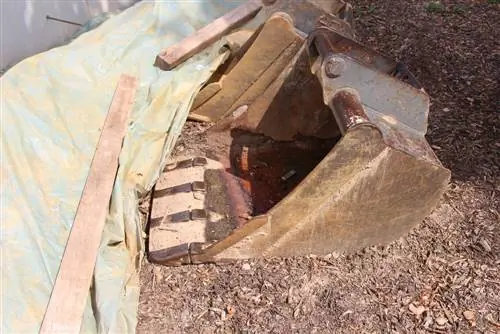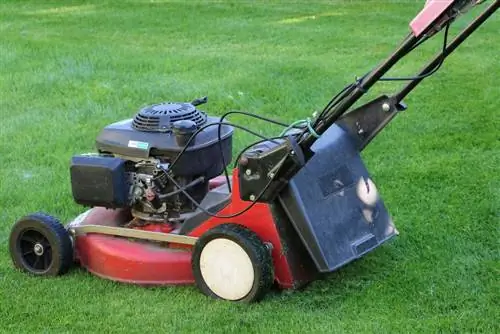- Author admin [email protected].
- Public 2023-12-17 03:39.
- Last modified 2025-01-24 12:45.
A lawn is indispensable in creative garden design. It creates visual width and space for a wide variety of leisure activities. Only if you create a lawn correctly will you develop a dense, durable green area that also meets aesthetic requirements. This premise applies just as much to sowing as it does to laying turf. The following instructions show what is important when creating a lawn. The overview of costs would like to help you decide between sowing seeds and rolling turf.
Creating a lawn by sowing
So that the sowing results in a lush green lawn, various decisions must be made in advance in connection with preparatory work. It is important to find the perfect seed mixture for the intended function of the green area as an ornamental, sports or play lawn. It is recommended to use high-quality products because they grow more slowly. The result is less frequent mowing, which may be of particular interest to hobby gardeners with limited free time. In addition, it is advisable to carry out a soil analysis in terms of pH. The test result provides reliable information about the extent to which the soil needs to be limed. Now the work can begin:
Soil preparation
In the first step, the work concentrates on the deep loosening of the soil. Although the lawn roots will reach a maximum depth of 10 centimeters, the topsoil should be broken up to a spade depth to prevent waterlogging. How to proceed:
- The optimal time to start work is the end of March/beginning of April
- Work the soil with a spade or a motor hoe
- Remove all stones and root residues
- Work a 2 centimeter thick layer of sand into heavily compacted soil
- Improve sandy soil with lime, clay powder and compost
- Then administer the starter fertilizer in the dosage according to the manufacturer's instructions
A break of two to three weeks is now recommended. Especially on new build properties, you should give the ground time to settle. In addition, previously dormant weed seeds will germinate in this phase and can be removed before sowing.
Tip:
The finer the soil is, the more effectively the grass seeds will establish themselves. Therefore, use a sieve to remove stones and roots.
Level surface
After the rest break, work the area again with the rake. Use a batten to level the floor. Ideally, you have a garden roller at your disposal to consolidate very loose soil a little. Alternatively, strap slats under your work shoes and walk around the area. However, this effort is only necessary if the topsoil is so airy that there is a risk of erosion or run-off even in the event of light rainfall.
Sowing
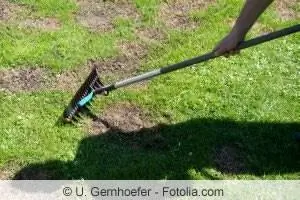
Seeds for lawns always consist of a mixture of different types of seeds. Therefore, mix the seeds well by hand before sowing. In this way you ensure a harmonious distribution, which results in an even lawn appearance. This is how it continues:
- The ground temperature is constantly more than 10 degrees Celsius
- Spread the lawn seeds with the spreader or by hand
- A dosage of 20-25 grams per square meter is considered appropriate
- Sowing lengthwise and crosswise prevents incorrect scattering
If you decide to sow by hand, plan on using a slightly higher amount of seeds to create a closed lawn area.
Tip:
Very fine seeds can be distributed better if they are mixed with a little bird sand.
Fix soil and water
Immediately after sowing, the area is secured with the lawn roller to ensure good soil connection. Alternatively, the tread plates can be used again under the shoes. Since lawn seeds germinate in the light, covering them is not recommended. Only in areas exposed to strong winds does a thin layer of peat serve to protect against wind drifts. The seeds must not be covered higher than 0.5 centimeters. In the last step, moisten the future lawn extensively with a fine watering spray. In the following 2 to 3 weeks, the freshly sown green area must be kept constantly moist. Hold the hose towards the sky so that the water falls like raindrops. If the area is larger than 100 square meters, it is worth investing in a lawn sprinkler.
First mowing
At a height of 6-8 centimeters, the time is ripe for the first cut. Cut your new lawn back to 3-4 centimeters. Ideally, you should not let an ornamental lawn grow higher than 4-6 centimeters so that you can trim it to around 3 centimeters. An exception is shaded lawn, which is not shortened to less than 5 centimeters.
Overview of the costs of sowing lawns
Provided that the work materials are available, such as spades, rakes, lawn rollers or spreaders, the costs for 100 square meters of lawn are at the following level:
- Lawn seeds: 10 to 25 euros
- Starting fertilizer: 10 to 15 euros
- In the combination package: from 40 euros
Instructions: Creating a lawn with rolled turf
Laying a lawn that forms a densely woven carpet in the same day; You can make this dream come true with rolled turf. Without already taking a look at the cost overview, it is obvious that this variant requires a higher budget than sowing. Since you, as an experienced hobby gardener, have the opportunity to lay the turf yourself, the financial outlay is kept within manageable limits. With these instructions everything goes smoothly:
-
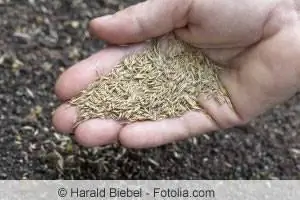
Create a lawn Laying turf is possible from March to September
- Fine crumbly preparation of the soil, as for sowing
- Apply starter fertilizer to the rolled subsoil and moisten it slightly
- Lay the first roll along a straight edge
- Tighten cords for orientation if necessary
- Place all other lawn rolls side by side and semi-offset
- Do not leave any joints or gaps
- Only walk on freshly laid pieces of lawn using slats
- Cut edge pieces into shape with a sharp knife
After all the lawn rolls have been laid, roll the area lengthwise and crosswise. Always only enter areas that have already been compacted.
Tip:
The pieces of grass left over after cutting are ideal for filling gaps.
It is important to note that the ground preparation is completed on the day the turf is delivered. After peeling in the lawn school, rolled turf must be processed within the next 24 hours. This is only possible if the rolls are cooled down to 3 degrees Celsius for transport to you using a special PreCool process. When the delivery arrives, the lawn has adapted to the ambient temperature to such an extent that longer storage is not possible.
Water consistently
Adequate water supply is crucial for success when creating a lawn with turf. Experience has shown that 95 percent of complications can be traced back to inadequate irrigation. A well-founded guide therefore does not forego detailed information on this central topic:
- Water the lawn thoroughly on the evening of installation
- In normal weather, a minimum of 15 liters per square meter is required
- Do not water under any circumstances under direct sunlight
- Repeat watering every 2 days for the next 2 weeks
The freshly laid lawn can be accessed from day one, for example to set up the lawn sprinkler. The green area will only be able to cope with higher levels of stress caused by children playing or a garden party after 3 to 4 weeks at the earliest.
The first cut
If the weather is favorable, warm and humid, the lawn mower can be used on the newly laid lawn within 5 to 7 days. Mowing takes place for the first time at the latest when the blades of grass have reached a height of around 5 centimeters. Since intensive irrigation is still taking place in this phase, this is initially reduced so that the grass area can dry out.
-
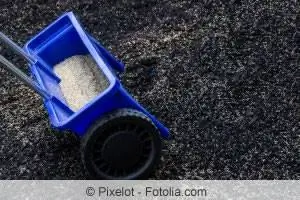
Create a lawn Don't trample the lawn before mowing
- Do not cut off more than 30 percent of the grass blades
- Do not mow in bright sunshine
In the weeks after installation, every cut contributes to the dense growth of the new lawn. While in later years the frequency of mowing is lower than that of sown lawns, the effort of increased lawn cutting in the initial phase is worth it.
Overview of the costs for rolled turf
Rolled turf is grown in huge turf nurseries over a period of 12 to 14 months, where it is peeled, cooled down and transported. As a result, the costs are at a significantly higher level than for sowing. The following amounts come together on average for 100 square meters of lawn:
- Play turf: 250 to 300 euros without external installation
- Decorative lawn: 300 to 350 euros without external installation
- Starting fertilizer: 10 to 15 euros
If you decide to leave the laying of the turf to a professional company, the costs will increase dramatically. The average price for a playing lawn is 1,100 euros for 100 square meters.
Conclusion
Creating a lawn properly is not a side project, even for experienced hobby gardeners. Intensive planning and soil preparation is required so that the lawn grows well. This premise applies regardless of whether the new lawn is created by sowing seeds or in the form of rolled turf. Sowing lawn seeds requires a little more work, whereas the costs here are at a low level. A rolled turf presents you with a lush green, dense appearance on the day it is laid, but this does come at a price. It is advisable not to make the final decision solely based on the costs. As a hobby gardener, you should delve into these instructions for creating lawns just as intensively and judge based on which challenge you feel you are up to.

